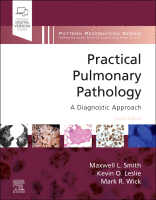Physical Address
304 North Cardinal St.
Dorchester Center, MA 02124

Introduction Pathologists may encounter pulmonary hypertension in biopsies, explanted lungs, or autopsies. Probably the most common setting is biopsies performed for the diagnosis of interstitial lung disease; in this situation recognition of pulmonary hypertension (and equally important, mimics of pulmonary…

Pulmonary vasculitis Overview of pulmonary vasculitis Inflammation of arteries and veins can occur in many inflammatory lung diseases, including infections. By convention, the diagnostic term pulmonary vasculitis is restricted to a relatively limited number of diseases in which vascular inflammation…

Overview and general considerations Pneumoconiosis literally means “dust in the lung” and the term has come to refer to disease of the lung related to the inhalation of dusts. Pneumoconioses are for the most part due to the inhalation of…

Three main histologic patterns of injury are encountered in the setting of airways disease; minimal change, nodules, and fibrosis. Minimal change is the classic pattern encountered in the setting of small airways disease or constrictive bronchiolitis from any etiology. In…

Diffuse or interstitial lung diseases (ILDs) include a spectrum of primarily nonneoplastic inflammatory conditions that share the common property of multilobar (but not necessarily complete) involvement of the lung parenchyma. The term ILD has become so thoroughly entrenched across multiple…

Histologic patterns of lung infection Infectious pathology can result in a variety of basic patterns of pulmonary pathology including acute lung injury, alveolar filling, cellular infiltrates, nodules, and fibrosis in order of decreasing frequency ( Table 7.1 ). Acute lung…

Practical approach to the differential diagnosis of acute lung injury for pathologists The basic elements of the acute lung injury pattern include interstitial edema, alveolar edema, fibrin, hyaline membranes, reactive pneumocytes, and organization (see Box 6.2 and Fig. 6.1 A–C).…

The diagnostic approach to pediatric lung biopsy differs somewhat from that in the adult patient. Many of the usual questions that arise in adult pulmonary pathology are replaced by separate issues involving abnormal development, altered lung growth due to prematurity,…

Foundations High-resolution computed tomography Computed tomography (CT) is the widely recognized imaging standard of reference for the assessment of most pulmonary abnormalities ( Fig. 4.1 ). With a diffuse lung disease (DLD), the high-resolution option is used. An actual collimation…

Optimal specimen handling is essential for the accurate interpretation of biopsies and cytologic preparations obtained in the course of evaluating the patient with lung disease. The limited number of sampling techniques available can be divided into three general categories: bronchoscopy,…